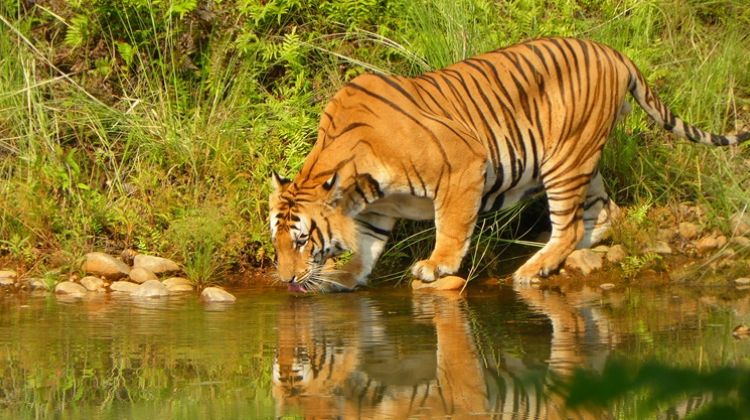
2 Aug 2022 Outdoor Himalayan
The growth of Tigers in Nepal has achieved the extraordinary feat of more than doubling its tiger population in the past 12 years. A victorious feat in bringing them back from the brink of extinction. According to the tiger census report of 2022, the total count of tigers has reached 355.
Nepal is a small land-locked country abundant in natural beauty and natural resources. Nepal has rich diverse flora and fauna. Nepal has 12 National parks, 7 conservation areas, and 1 wildlife reserve. It is home to many species of wild animals and birds. Among the five species of Tigers, Nepal is home to the “Bengal Tiger” (Panthera Tigris). It is widely known as the “Royal Bengal Tiger” in Nepal.
The first tiger census began in Nepal in the year 1995. The total numbers of tiger were 98. There were 121 tigers in the year 2010. The 13 Tiger Range countries came together to launch the “Tx2 Initiative”. The increase in Tiger numbers is possible due to a global goal to double the number of wild tigers by the year 2022.
In the context of Nepal, there are 128 tigers in Chitwan National Park, 125 tigers in Bardiya National Park, 40 tigers in Parsa National Park, 36 tigers in Shuklaphanta National Park, and 25 tigers in Banke National Park.
Around the world, 93% depletion of tigers due to the non-existence of tiger’s traditional range. It happened due to habitat loss, poaching, and lack of prey. This is a very alarming situation and necessary steps must be taken to prevent the tigers from being extinct.

Reasons for Tiger Extinction in Nepal
In Nepal’s context, the present Tiger preservation areas used to be the royal hunting ground. Some other reasons are:
- Tiger hunting by Royal family members for entertainment purposes in the ’60s and ’70s
- Hunting by commoners for pleasure and tiger’s fur
- Poaching for their precious fur, teeth, and claws
- Natural Habitat Loss due to human population growth and colonization
- The disappearance of Swamp deer (primary prey for tigers)
- Death of tigers due to scarcity of food
Even in the present scenario, a threat to the tiger remains. But, numerous conservationists and several organizations working for wildlife preservation and the government are continuously trying their best. Many initiatives to preserve Tigers have been introduced on the global platform. The 13 Tiger Range nations are also working and making strong government laws to preserve tigers in their respective nations. The tiger population double in Nepal is the rewarding outcome of the efforts of this initiative.
Joyous Moment:
Success for numbers of Tiger Growth in Nepal
Nepal is a member of the Tiger Range countries together with the other 12 countries. They join hands together to preserve the tigers and increase their numbers. As a result, they launch the “Tx2 Initiative” whose global goal was to double the number of wild tigers by the year 2022. Nepal took this initiative seriously and follows essential steps for it. As a result, Nepal has become the first country to keep a promise to double the tiger in the decade. It is a joyous moment for all. Some reasons for the success of numbers of Tiger growth in Nepal are:
- Strong enforcement against poaching, hunting
- Military army units patrolling the national park daily
- Capital Punishment for poachers, hunters
- Involvement of enforcement agencies, conservation partners
- Communities living alongside the vicinity of Tigers
Fearful Moment:
How does the growth of Tigers create fear moments in Nepal?
The national parks, conservation areas, and wildlife reserves lie in the vicinity of human settlements. The common area shared between the humans and Tigers is very close. Many Nepalese locals residing near the national parks have to travel the road in the vicinity of forests daily. For collecting woods, and other materials, locals travel to the forest. This is a very risky situation as they encounter tigers often.
Just in the past year, 16 individuals have lost their lives to the tiger attack. The number of victims may soar and many families might suffer if timely preventive measures are not taken. It is truly a fearful moment. The community is living in terror. The community is paying the price as the world is rejoicing in the growth of tigers. It is a challenging job to maintain peace between two species i.e. humans and tigers.
Here in Nepal, the Tigers killing humans are tracked down. They are kept in custody. Currently, there are seven tigers behind bars.
Beneficiary safety tips for both Tigers and Humans
- Relocate the villages outside the protected area
- Create a limited safe zone for humans to travel in the forest/parks
- Mark the restricted area for humans in the forest/parks
- Create Buffer Zones around the National Parks
- Construct an Animal underpass to cross them safely on the highway
- Travel less during the night by humans as tigers are mostly active
How is Tiger Census done in Nepal?
An example of Bardiya National Park is presented for the Tiger census. Inside the Bardiya National Park, hundreds of hidden cameras are installed. From those cameras, Tiger censuses are done. One might wonder how they can differentiate among the tigers. The answer is simple. Human fingerprints are different likewise tigers also have different stripes. These different stripes help to distinguish and make it easy in counting.
Conclusion
Tigers are necessary for shaping the environment ecosystem. The preservation of tigers and their growth is significant for the flourishing of other species. Tigers are the natural protectors of the forest. Tiger helps to maintain a balance between the prey animals and the forest vegetation. It is a piece of joyful news about the numbers of growth of Tigers.
With strong enforcement of laws for Tiger protection and proper relocation of human settlement both humans and tigers can be safe and live in peace. Humans need not live in fear onwards. Ultimately, the growth of Tiger in Nepal remains forever a joyful moment. In a nutshell, Nepal has played a small but vital role in the protection of tigers from being extinct.
# 13 Tiger Range Countries (TRC): Nepal, Bangladesh, Bhutan, Cambodia, China, India, Indonesia, Laos, Malaysia, Myanmar, Thailand, Russia, Vietnam
Courtesy : BBC News
TAGS: Bardiya National Park Chitwan National Park Tiger Census Tiger Growth

